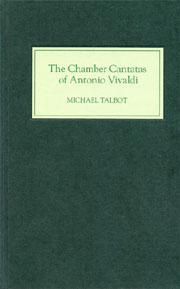Book contents
- Frontmatter
- Contents
- List of music examples
- List of tables
- Preface
- Conventions and abbreviations
- 1 The Rediscovery of Vivaldi's Cantatas
- 2 The Cantata Genre
- 3 Vivaldi and the Voice
- 4 The Mantuan Cantatas
- 5 Cantatas of the Middle Years
- 6 The Dresden Cantatas
- 7 Vivaldi's Cantatas in Perspective
- Glossary
- List of Vivaldi's cantatas published in the New Critical Edition
- Spurious works
- Bibliography
- Index to musical works
- General index
1 - The Rediscovery of Vivaldi's Cantatas
Published online by Cambridge University Press: 12 September 2012
- Frontmatter
- Contents
- List of music examples
- List of tables
- Preface
- Conventions and abbreviations
- 1 The Rediscovery of Vivaldi's Cantatas
- 2 The Cantata Genre
- 3 Vivaldi and the Voice
- 4 The Mantuan Cantatas
- 5 Cantatas of the Middle Years
- 6 The Dresden Cantatas
- 7 Vivaldi's Cantatas in Perspective
- Glossary
- List of Vivaldi's cantatas published in the New Critical Edition
- Spurious works
- Bibliography
- Index to musical works
- General index
Summary
How Contemporaries saw them
In his own day Vivaldi's cantatas went almost unnoticed. The thirty-seven that survive today, which probably represent a high proportion of the original total, may seem a respectable enough number, but viewed as a segment of his oeuvre, or in comparison with the cantata output of the ‘big producers’ of his time, they make little impression. This rather negative statistical assessment is based on a general impression, but the thrust of the argument receives support from Table 1.1, in which the output of six major composers of Vivaldi's time in four genres (opera, cantata, concerto, sonata) is compared. Vivaldi's cantatas represent only about 6 per cent (the bracketed figure) of his works in the four categories, and this percentage would reduce further if his sacred works of all kinds and his serenatas were thrown into the balance. The composer among the five others whose profile resembles his most closely is Albinoni, who, as a fellow Venetian, enjoyed similar opportunities as a composer. But even here, the difference between 19 and 6 per cent is not negligible. Scarlatti, Marcello, and Bononcini emerge from the table as the specialists in the genre, and one is not surprised to find their names singled out frequently in this connection in the literature contemporary with Vivaldi.
Of course, gross numbers are not everything. Pergolesi achieved stardom in the domain of sacred vocal music with a single work, his Stabat Mater (1736), which circulated everywhere in Europe, not excluding Protestant regions.
- Type
- Chapter
- Information
- The Chamber Cantatas of Antonio Vivaldi , pp. 1 - 24Publisher: Boydell & BrewerPrint publication year: 2006



